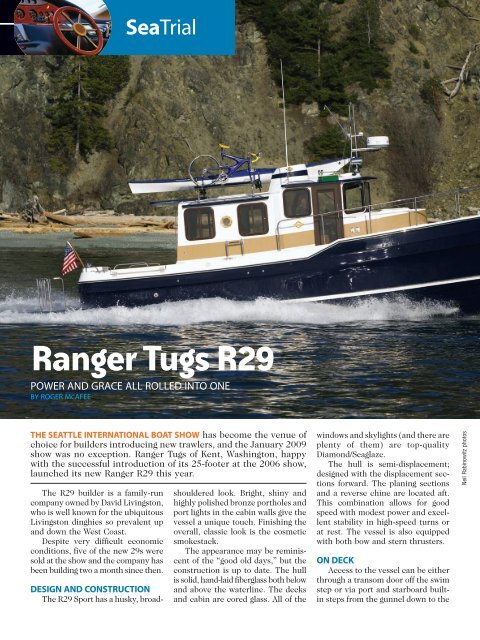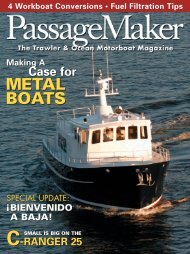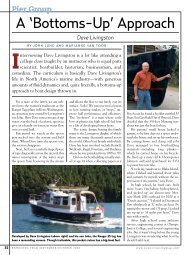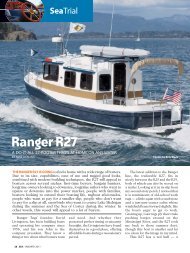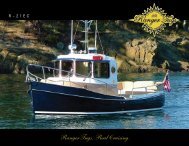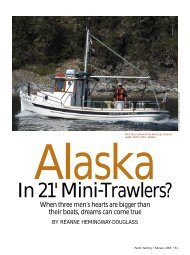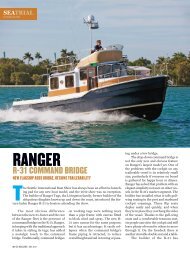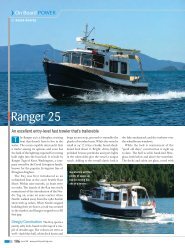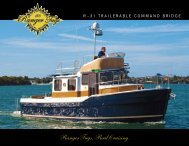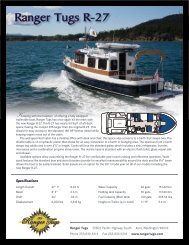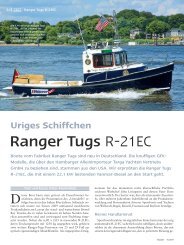ranger tugs r29: power and grace all rolled into one
ranger tugs r29: power and grace all rolled into one
ranger tugs r29: power and grace all rolled into one
- No tags were found...
Create successful ePaper yourself
Turn your PDF publications into a flip-book with our unique Google optimized e-Paper software.
SeaTrialRanger Tugs R29POWER AND GRACE ALL ROLLED INTO ONEBY ROGER MCAFEETHE SEATTLE INTERNATIONAL BOAT SHOW has become the venue ofchoice for builders introducing new trawlers, <strong>and</strong> the January 2009show was no exception. Ranger Tugs of Kent, Washington, happywith the successful introduction of its 25-footer at the 2006 show,launched its new Ranger R29 this year.The R29 builder is a family-runcompany owned by David Livingston,who is well known for the ubiquitousLivingston dinghies so prevalent up<strong>and</strong> down the West Coast.Despite very difficult economicconditions, five of the new 29s weresold at the show <strong>and</strong> the company hasbeen building two a month since then.DESIGN AND CONSTRUCTIONThe R29 Sport has a husky, broadshoulderedlook. Bright, shiny <strong>and</strong>highly polished bronze portholes <strong>and</strong>port lights in the cabin w<strong>all</strong>s give thevessel a unique touch. Finishing theover<strong>all</strong>, classic look is the cosmeticsmokestack.The appearance may be reminiscentof the “good old days,” but theconstruction is up to date. The hullis solid, h<strong>and</strong>-laid fiberglass both below<strong>and</strong> above the waterline. The decks<strong>and</strong> cabin are cored glass. All of thewindows <strong>and</strong> skylights (<strong>and</strong> there areplenty of them) are top-qualityDiamond/Seaglaze.The hull is semi-displacement;designed with the displacement sectionsforward. The planing sections<strong>and</strong> a reverse chine are located aft.This combination <strong>all</strong>ows for goodspeed with modest <strong>power</strong> <strong>and</strong> excellentstability in high-speed turns orat rest. The vessel is also equippedwith both bow <strong>and</strong> stern thrusters.ON DECKAccess to the vessel can be eitherthrough a transom door off the swimstep or via port <strong>and</strong> starboard builtinsteps from the gunnel down to theNeil Rabinowitz photos30 SEA / AUGUST 2009
cockpit sole. Substantialstainless steelh<strong>and</strong>rails make boardingeasy <strong>and</strong> safe, <strong>and</strong>the swim step itselfhas high safety rails.It is positi<strong>one</strong>d atabout the same heightas most floating docks,making it an easy stepfrom dock to boat.This will be especi<strong>all</strong>yappreciated byboaters with sm<strong>all</strong>children or elderlyparents. The decksthemselves are coredglass with a moldedinnonskid pattern.Moving forward fromthe cockpit along thenarrow sidedeck ismade possible by acabin-top h<strong>and</strong>rail,but this maneuvershould not be d<strong>one</strong>under way. Onceyou're on the foredeck,h<strong>and</strong>rails providegood security.The foredeck can alsobe reached through apilothouse sliding doorat the starboard helmstation or through anoverhead hatch fromthe foc’s’le.The cockpit itself isrelatively large <strong>and</strong>has a stainless sink,with a pullout shower faucet in thetransom coaming. Having water <strong>and</strong>a sink in the cockpit of a sm<strong>all</strong> boatis unusual <strong>and</strong> will be appreciated byexperienced cruisers <strong>and</strong> avid fishermenalike. Another nice feature isthe built-in steps hinged at the coamingthat swing up to <strong>all</strong>ow access toequipment <strong>and</strong> a relatively largestowage space tucked neatly under thesteps.INSIDEUpon entering the deckhouse thefirst thing you’ll notice is that theentire area is flooded with natur<strong>all</strong>ight. There are 10 windows <strong>and</strong> twobronze portholes in the cabin sides,An Inside LookTESTER'S OPINION:“The R29 represents a good step up from Ranger’s R25. It is economical, capable of a goodturn of speed <strong>and</strong> h<strong>and</strong>les well. The designers have made smart use of space, <strong>and</strong> <strong>all</strong> equipment<strong>and</strong> gear can be easily accessed for routine service.”The first thing you’ll notice upon entering the deckhouse is that the entire area is floodedwith natural light. There are 10 windows <strong>and</strong> two bronze portholes in the cabin sides, plusthe large glass area in the cabin aft door. There are four overhead skylights in the maincabin, another in the foc’s’le <strong>and</strong> <strong>one</strong> in a combination head/shower space.plus the large glass area in the cabinaft door. There are four overhead skylightsin the main cabin, another inthe foc’s’le <strong>and</strong> <strong>one</strong> in a combinedhead/shower space. The flood of daylightgives the appearance of morewindow glass than fiberglass in thedeckhouse.7The layout is typical for boats thissize; a dinette converts to a berthalong <strong>one</strong> side (in this case to port<strong>and</strong> the g<strong>all</strong>ey along the starboardside). There are two stainless sinkswith a central, single faucet, whichis an excellent feature. Once againan indication that Ranger designersare experienced boaters. The g<strong>all</strong>eyalso boasts a propane stove with anFREE PRODUCT INFORMATION, VISIT WWW.SEAMAGAZINE.COM 31
Ranger TugsR29SPECIFICATIONSLength over<strong>all</strong>w/swim stepBeamDraftFuel mainFuel auxWaterHeight on traile<strong>r29</strong> ft.33 ft.10 ft.28 in.120 gals.30 gals.70 gals.13 ft., 2 in.STANDARD EQUIPMENTYanmar 260 HP diesel engine, bow <strong>and</strong> sternthruster for easy maneuverability,propanestove/oven, 2,500 watt inverter (quiet 110<strong>power</strong> when away from the dock),isl<strong>and</strong> masterberth, pilothouse door on starboard side foreasy access to the bow <strong>and</strong> tie lines, level entry<strong>into</strong> the saloon from the cockpit w/no stairs,midship berth with privacy door sleeps two,large g<strong>all</strong>ey with plenty of storage, trailerable.OPTIONAL EQUIPMENTW<strong>all</strong>as forced air diesel furnace, Garmin 5215navigation package with radar, GPS, Sonar,Garmin autopilot for those longer cruises, 4kwMase Generator, air conditioning <strong>and</strong> more.CONSTRUCTIONThe over<strong>all</strong> construction technique is modularin design. This eliminates the use of wood forstiffening. All bulkheads are fiberglass <strong>and</strong>part of the interior module or deck. The hull ish<strong>and</strong> laid solid fiberglass construction. Theydo not use any coring in the hull or stringer ofthe boat. The stringer system is a <strong>one</strong>-piecefiberglass stringer (no wood) that is laminatedto the hull prior to the boat being removedfrom the mold. This prevents the hull fromwarping or deforming when removed from themold. Ranger uses vinylester resin on theentire hull of the boat to prevent osmotic blistering.They even go as far as laminating solidlead ingots <strong>into</strong> the stringer system to bolt theengine to. This reduces vibration <strong>and</strong> noise<strong>and</strong> will last forever.BUILDERRANGER TUGS, Kent, WA; (253) 839-5213;www.<strong>ranger</strong><strong>tugs</strong>.com.oven, a built-in microwave, a 12-voltrefrigerator/freezer <strong>and</strong> a temperaturecont<strong>rolled</strong>wine cooler that holds sixbottles.The forward cabin is bright <strong>and</strong>very spacious for a vessel of this size<strong>and</strong> comes complete with an isl<strong>and</strong>berth, <strong>and</strong> a separate head completewith a sm<strong>all</strong> vanity <strong>and</strong> shower. Thereis ample storage space for a cruisingcouple.A second, midship berth is locatedunder the dinette <strong>and</strong> immediatelyto port on entering the salon fromthe cockpit. It’s not the usual dim,cramped, space <strong>one</strong> typic<strong>all</strong>y finds ina setup of this nature. It is larger <strong>and</strong>brighter, <strong>and</strong> the double mattress islarge enough for an adult couple tosleep comfortably.The helm station is forward of theg<strong>all</strong>ey, <strong>and</strong> a lookout seat is locatedforward of the dinette. Visibility fromboth seats is excellent <strong>all</strong> around.A teak <strong>and</strong> holly cabin sole promisesgood wear, <strong>and</strong> the various itemsof teak trim are well fitted.POWEROur test vessel was equipped witha single 260 hp Yanmar 6BY2 inboarddiesel. This six-cylinder, 694-pound,common-rail engine displaces only 183cubic inches, yet at its continuous ratingof 3600 rpm it produces 198 hp.At that speed it’s still almost at thetop of its torque curve.The engine is freshwater, heatexchanger cooled <strong>and</strong> is also turbocharged<strong>and</strong> intercooled. It operatedsmoothly, starting quickly <strong>and</strong>without smell or smoke. That re<strong>all</strong>yshould be no surprise since Yanmarbuilt <strong>one</strong> of the world’s first sm<strong>all</strong> commercialdiesel engines 76 years ago.They’ve had time to get it right.UNDER WAYAs expected with both a bow <strong>and</strong>stern thruster, moving away from thedock was no problem. At idle, 670 rpm,the sm<strong>all</strong> trawler ghosted along at 3knots, burning just less than half a g<strong>all</strong>onper hour. At 1000 rpm the vesselmade 4.5 knots, consuming .7 g<strong>all</strong>onper hour. At 1750 rpm we were making7.2 knots <strong>and</strong> burning 2 g<strong>all</strong>onsper hour.At this speed I hauled out my decibelmeter to conduct a noise test(which is re<strong>all</strong>y unfair to sm<strong>all</strong>, lightlybuilt trawlers). Vessels in this categorydon’t have either the space orthe weight <strong>all</strong>owance for a lot of soundinsulation or baffling. At 1750 revs thenoise level was 72 decibels — less thanthe average radio — <strong>and</strong> much quieterthan I expected.At 2500 rpm we moved along at9.7 knots <strong>and</strong> burned 4.7 g<strong>all</strong>ons perhour. At 3000 rpm our speed was 14knots, <strong>and</strong> fuel burn was 7.3 g<strong>all</strong>onsper hour. At the engine's continuousrating, 3600 rpm, we scooted alongat 18 knots burning 9.8 g<strong>all</strong>ons perhour.At wide-open throttle — 4000 rpm— we topped out at 22.5 knots <strong>and</strong>were burning 12.7 g<strong>all</strong>ons per hour.All test speeds were GPS generated.Sea conditions at the time of ourtest were moderate <strong>and</strong> the vessel h<strong>and</strong>ledthem well. We added in somewake <strong>and</strong> found that, even with theadded wave height <strong>and</strong> sea confusion,the vessel was stable, solid <strong>and</strong> wellbehaved.We took the way off, cranked thehelm hard over <strong>and</strong> slowly acceleratedto full throttle while keeping thehelm hard over to port. The vesselpicked up a very slight list to starboarduntil the engine reached about 1000rpm <strong>and</strong> then flattened out <strong>and</strong>leaned slightly to port as it dug <strong>into</strong>the turn.We straightened out <strong>and</strong> afterreaching full speed, cranked the helmfrom hard port to hard starboard. Thevessel carved the turns cleanly, withoutfuss or muss.IN SUMMARYThe R29 represents a good step upfrom Ranger’s R25. It is economical,capable of a good turn of speed <strong>and</strong>h<strong>and</strong>les well. The designers havemade smart use of space, <strong>and</strong> <strong>all</strong> equipment<strong>and</strong> gear can be easily accessedfor routine service.The ability of the vessel to comfortablylive on a trailer substanti<strong>all</strong>yreduces operating costs while at thesame time <strong>all</strong>ows the vessel to betowed to distant cruising grounds. Towvehicles get much better mileagethan boats. Over<strong>all</strong> the Ranger R29will turn out to be a winner.32 SEA / AUGUST 2009


